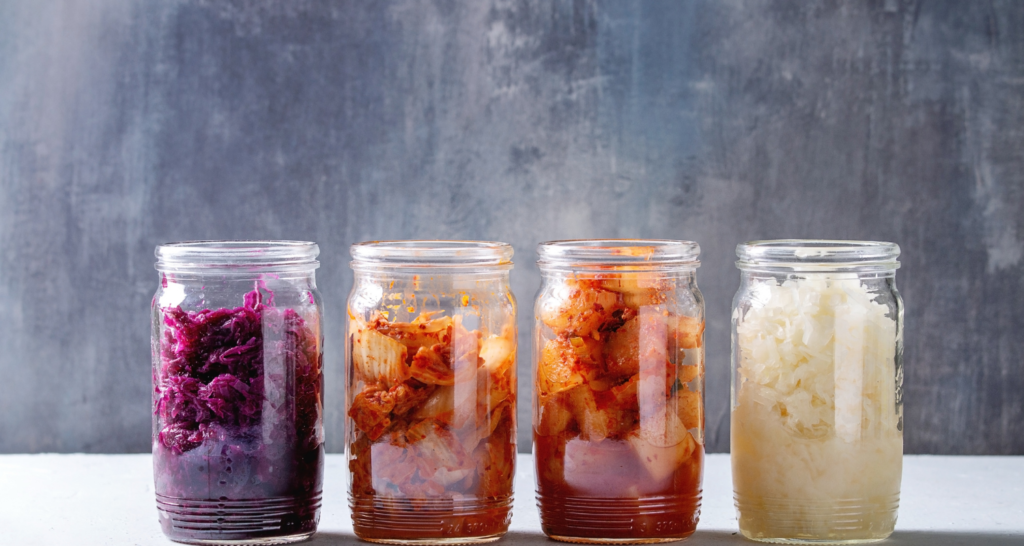You may know that I’m a big proponent of focusing on increasing your gut health. I’ve talked about it many times, including in this article on the gut microbiome. When your gut health is in top form, your overall health follows. The strength of your gut microbiome determines the strength of your immune system, your weight, and even your brain health.
But have you ever wondered how earlier civilizations cultivated their healthy gut bugs?
They obviously weren’t running to the drugstore to grab a bottle of probiotics.
What they were eating was a diverse array of plant foods that were full of prebiotic fiber…and in the winter when vegetables were scarce, they ate fermented foods.
Fermented foods aren’t necessarily part of our regular diets these days, but they used to be important staples. I’d like to argue that they should make a comeback — and recommend you eat them daily.
How Do Probiotics Work?
Fermented foods are full of probiotics. Which means they are full of microscopic organisms that are beneficial members of the large colony of bacteria that live in your gut.
This colony lives in your large intestine, and it can actually weigh about 4 pounds.
Which means there are quite a few of these tiny little guys living in your large intestine at any one time.
Generally, this colony is comprised of beneficial bacteria — the types of bacteria that help overcome a pathogen that makes its way into your body. But sometimes, due to poor diet, antibiotic use, or lack of sleep, the more sinister members of the colony start to become the majority party. Which leads to health problems.
Probiotics are basically a way to add directly to the colony of good guys. They arrive in your gut ready to add to the crew of beneficial, health-boosting bacteria so that the home team can take the advantage again and eradicate any bad actors looking to do harm.
Probiotics have been shown to support the immune system, improve digestion, and decrease inflammation. They’ve even been touted as a cure for acne.
Basically, probiotics are an amazing way to support your health — and fermented foods are a natural and affordable way to add them into your life.

What Are The Best Fermented Foods?
The best fermented foods are the ones that you will eat. While there’s a fermented food for every taste and diet, here’s a list of some of the most popular and easy to find choices.
Yogurt
Yogurt’s a classic for its delicious flavor and rich, creamy texture. But be sure to read labels if you’re buying yogurt at the grocery store. You want to make sure it actually has “live and active cultures” in it to get the probiotic benefits. And skip the sugary varieties…some have as much sugar as a candy bar.
Kefir
Kefir’s another dairy-based ferment that has a slightly more liquid texture than yogurt. Again, be careful of sugar content here. Don’t want to end up feeding the wrong gut bugs with too much sugar.
Miso Paste
Miso is a classic fermented soy product that has been enjoyed since the 4th century B.C. This delicious and complex blend lends a sweet, savory, and earthy flavor to anything it’s added to. Miso paste is popularly used to flavor soup broth, but can also be used in salad dressings and marinades.
Tempeh
Another popular fermented soy product, tempeh is rich in both protein and probiotics. Its ability to absorb flavors easily makes it a great vegan alternative to meat.
Sauerkraut
Sauerkraut may well be the best known fermented food in the U.S. While it’s known for the tangy flavor it brings to a Reuben sandwich, it’s also packed with gut-healthy probiotics.
Kimchi
Sauerkraut’s cousin kimchi is also made by fermenting cabbage, but its flavor is kicked up a notch by the addition of ginger, garlic, and chili peppers.
Kombucha
Kombucha’s rise in popularity is likely because of its fizzy fun and delicious flavor. But it’s also full of probiotics, since it’s a fermented sweet tea.
How To Make Your Own Fermented Foods
People have been making fermented foods for thousands of years, and it’s really simple to do at home. Which is great news if you can’t find high-quality fermented foods at the store, or you’d rather have certain vegetables than others. Plus, you can customize your ferments with the spices and flavors you prefer — which means you’ll be looking forward to having a spoonful with every meal, right?
Basically, any vegetable combined with salt and time will result in a fermented veggie. There are easy to follow recipes and instructions on the internet, but beets, carrots, green beans, cauliflower, and radish are some popular choices for making into fermented goodness.
Fermenting your own veggies is easy and a ton of fun.
Of course, if you prefer the less tangy version — you can always purchase probiotics that you simply have to swallow here.
Join The Fermented Food Fan Club
OK, so there’s not *really* a fan club, but if there were, I’d definitely join.
Fermented foods are like having a short cut to good health that’s also affordable — who wouldn’t be a fan?
If you’re a fan too, reach out on social media and let me know! Especially if you have any luck fermenting your own veggies. I can’t wait to hear about your experiences.
You can find me on Instagram here.
References
“Probiotics and immune health – NCBI – NIH.”
https://www.ncbi.nlm.nih.gov/pmc/articles/PMC4006993/.
“The effect of probiotics on immune regulation, acne, and ….” 6 Apr. 2015, https://www.ncbi.nlm.nih.gov/pmc/articles/PMC5418745/.
“Health benefits of fermented foods – PubMed.”
https://pubmed.ncbi.nlm.nih.gov/28945458/.
“Evidence of the Anti-Inflammatory Effects of Probiotics and ….” 28 May. 2017, https://www.ncbi.nlm.nih.gov/pmc/articles/PMC5490534/.
“Regular Consumption of Sauerkraut and Its Effect on Human ….” 1 Nov. 2014, https://www.ncbi.nlm.nih.gov/pmc/articles/PMC4268643/.
“(PDF) PROBIOTICS IN FRUITS AND VEGETABLES ….” https://www.researchgate.net/publication/273452753_PROBIOTICS_IN_FRUITS_AND_VEGETABLES_TECHNOLOGICAL_AND_SENSORY_ASPECTS.
“Fermented Fruits and Vegetables of Asia: A Potential Source ….” 28 May. 2014, https://www.ncbi.nlm.nih.gov/pmc/articles/PMC4058509/.
“Inclusion of Fermented Foods in Food Guides around the World.” 8 Jan. 2015, https://www.ncbi.nlm.nih.gov/pmc/articles/PMC4303846/.
“Probiotics in Autoimmune and Inflammatory Disorders.” 18 Oct. 2018, https://www.ncbi.nlm.nih.gov/pmc/articles/PMC6213508/.


